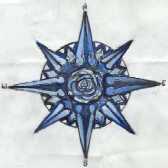 |
The Compass Rose, Vol. 1, No. 1, Summer 2000 |
|
In the Name of God
by
Notes and References
Notes
- The primary source for this paper is C. Warren Hollister's Medieval Europe: A Short History (1982:185-194), but I am a specialist in medieval studies. Some details are taken from classes I've taken and/or taught over the last two and a half decades.
- Some scholars list as many as nine officially numbered Crusades. The general criteria for an "official" Crusade are: (1) The Crusade must be called for in a sermon by the Pope or by a high-ranking cleric whose call is subsequently acknowledged by the Pope, (2) The Crusade must be aimed at securing control of the Holy Land in the Middle East (Note, this is the stated "aim" of the Crusade, not necessarily the end result.), and (3) The Crusade must involve actual military combat.
- The site believed to be the tomb of Jesus.
- For this and other information about spirituality in the Middle Ages, see Leclercq 1968.
- The cycle of folklore spawned by Charlemagne is positively enormous; only the traditions of King Arthur, the Knights of the Round Table, and the Holy Grail come close to the bulk of traditional stories generated by Charlemagne's conquests.
- The concept of the Nine Worthies arose in 1310 when Jacques de Longuyon compiled the list of three pagans, three Jews, and three Christians for the bishop of Liége. Arthur was included with Charlemagne and Godfrey de Bouillon as one of the three Christian kings.
- For readings on ecclesiastical and state policy toward the Jews during the Crusades, see Chazan 1980. For an overview of the policies toward the medieval Jews on the eve of the Crusades, see Bachrach 1977.
- The Sanct-Sang relics were associated with the blood of Jesus, either from when he hung on the Cross, when his body was taken down or when his body was entombed in the Holy Sepulcher. One of these relics was brought to Burges by the father of Philip d'Alsace, the man who commissioned Chrétien de Troyes to write stories about King Arthur and the Holy Grail. For a concise summary of the Sanct-Sang traditions and an extensive list of references, Malcor 1991:263-289.
- A similar story is told about King Arthur during this time period; one variant has him sleeping beneath a hill in Wales, while others have him sleeping in Mount Etna or on the Isle of Avalon. For a discussion of the tradition and references, see Ward 1981, Legend numbers 23, 28, 296, 297, 445, 494, 558 and 573 and Ward's commentaries on these legends.
- This infamous fight has been portrayed as everything from a difference of opinion about the course by which they should take their troops to the Holy Land to a spat between homosexual lovers. Only Richard and Philip ever knew for certain what the dispute involved.
- For information about the Robin Hood legends, see Holt 1989.
- For more information, see Malcor 1991.
- It is possible that folktales such as the Pied Piper of Hamlin are a folk memory of this Crusade.
- While some encyclopedias call this the "Sixth Crusade," most medieval scholars do not give these incidents a number.
- Some encyclopedias refer to this as the Seventh Crusade.
- Many scholars do not count this military expedition as an official part of the Crusades.
- The future Edward I.
- Hollister 1982:185.
References Cited
Bachrach, Bernard S. 1977. Early Medieval Jewish Policy in Western Europe. Minneapolis: University of Minnesota Press.
Chazan, Robert, ed. 1980. Church, State and Jew. New York: Behrman House.
Hollister, C. Warren. 1982. Medieval Europe: A Short History. New York: John Wiley & Sons.
Holt,J.C. 1989. Robin Hood. London: Thames and Hudson.
Leclercq, Jean. 1968. "Part One: From St. Gregory to St. Bernard: From the Sixth to the Twelfth Century." In The Spirituality of the Middle Ages. Translated by the Benedictines of Holme Eden Abbey, Carlisle. New York: Seabury Press.
Malcor, Linda A. 1991. The Chalice at the Cross: A Study of the Grail Motif in Medieval Europe. Ann Arbor, MI: UMI, No. 9126908, diss.
Ward, Donald J., ed. and trans. 1981. The German Legends of the Brothers Grimm, 2 vols. Philadelphia, PA: Institute for the Study of Human Issues.
© Linda A. Malcor 2000. All rights reserved.
This edition © The Compass Rose 2000. All rights reserved.

